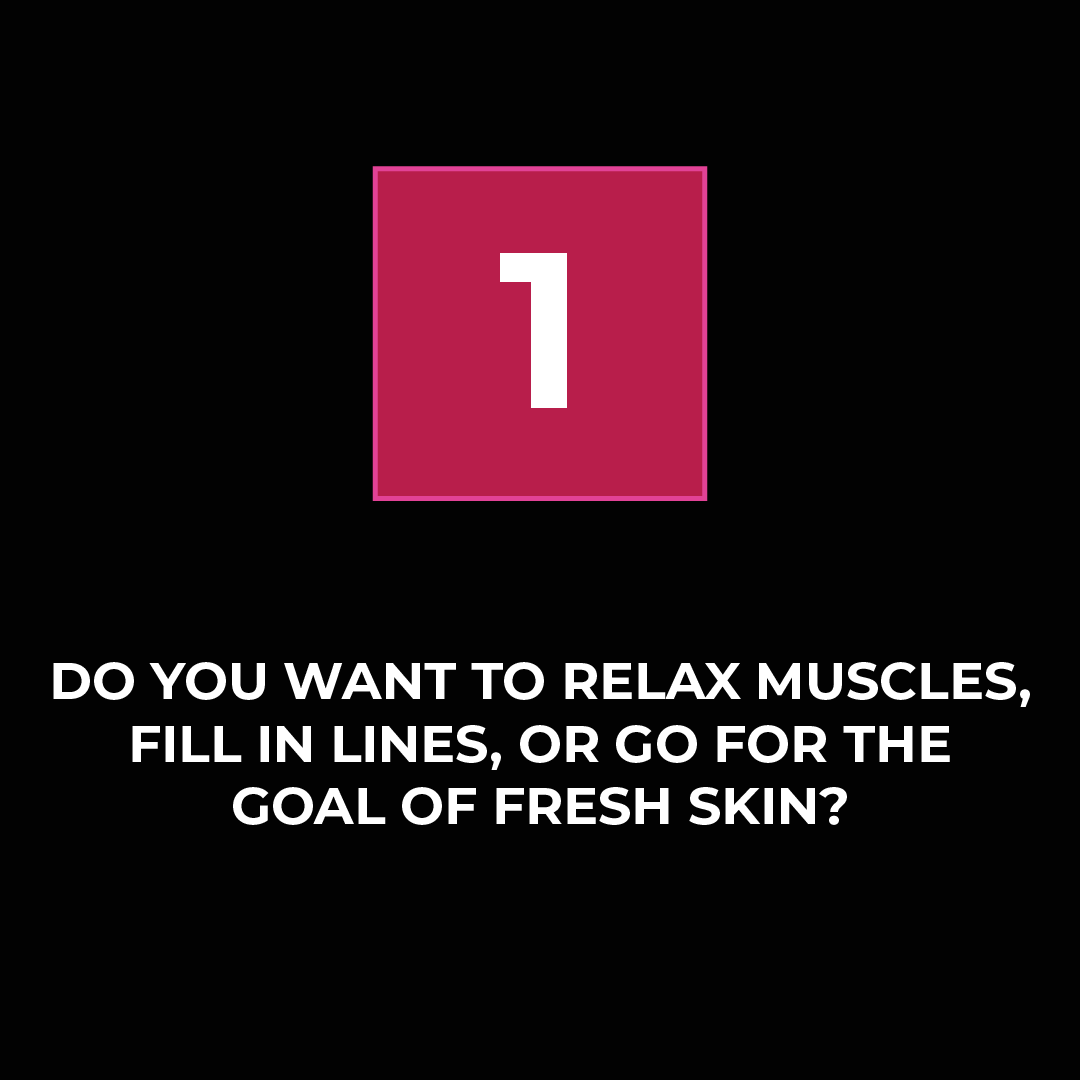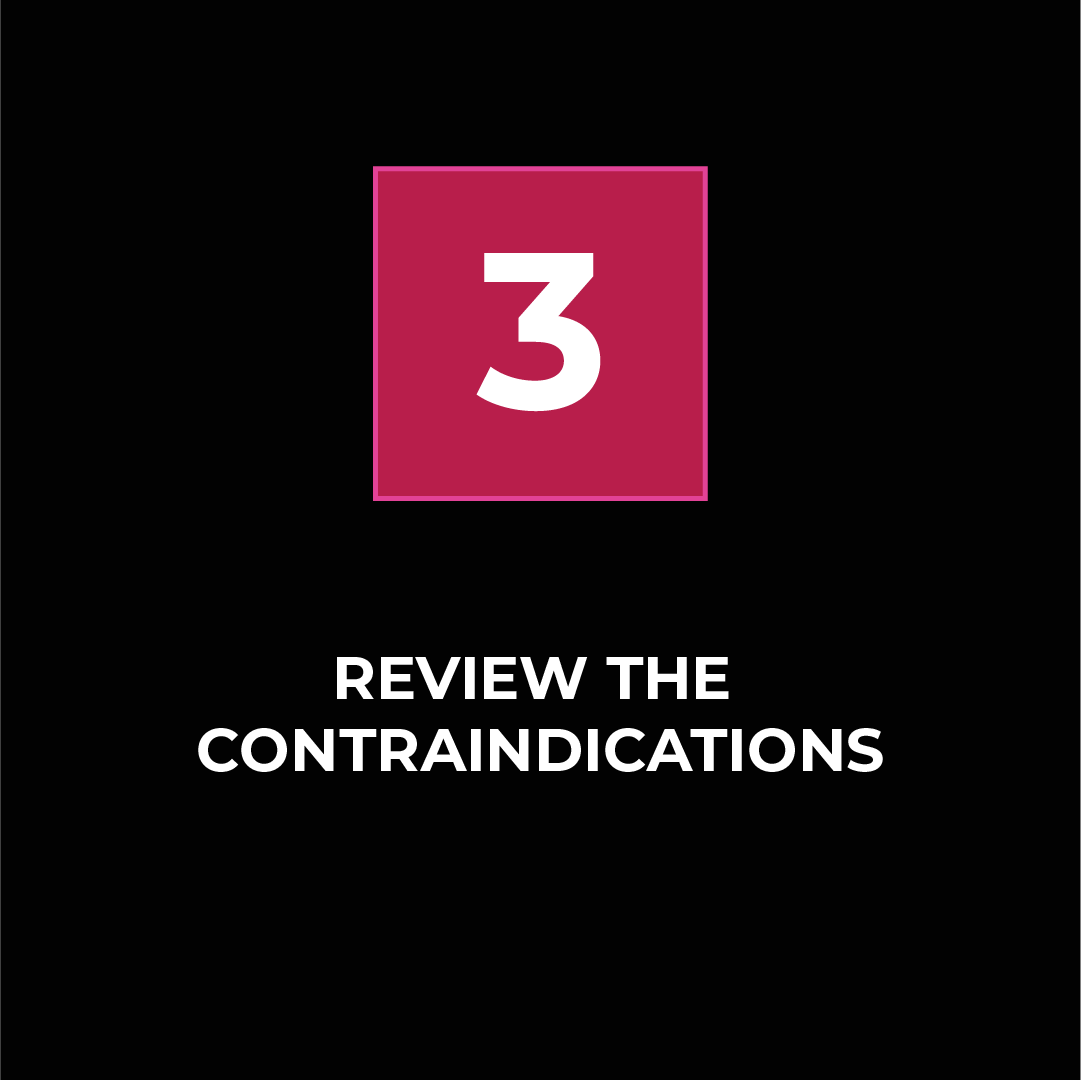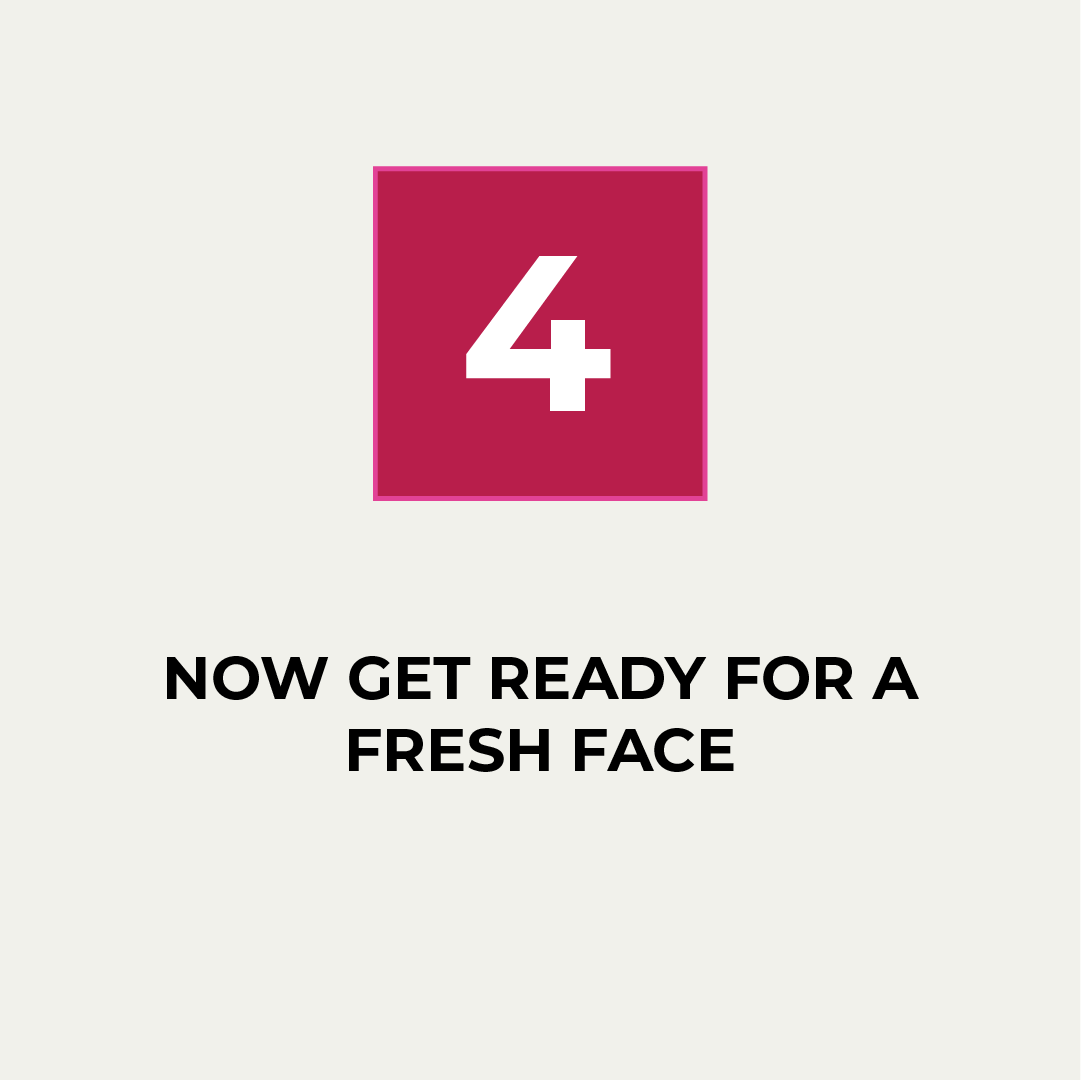Botox, Filler, B12 Injections, PRFM 101
How It Works
Wrinkle Relaxers Prep + Post Treatment
-
To prepare for your injectable treatments please arrive with clean skin and no makeup. To decrease risk of bleeding or bruising please avoid aspirin, ibuprofen, naproxen, Vitamin E, Fish Oil, & Ginko Biloba for 1 week prior to treatment, unless otherwise instructed by your physician. You may wish to begin taking Arnica sublingual tablets 2 or 3 days prior to treatment as well.
-
You will have little bumps at the injection sites after treatment, this is normal and will usually dissipate within an hour
Do not massage or put any pressure on the treated area for 6 hours (including tight hats, lying face down on a massage table, etc.)
Keep your head above your heart for 4 hours (do not lay completely flat)
Do not exercise for 6 hours
Avoid saunas and/or steam rooms for 6 hours, or anything that causes excessive sweating
If you experience bruising, apply arnica cream to the area to speed up healing
Your treatment can take up to 10-21 days to take full effect. If you have not achieved your treatment goals within 21 days, additional units may be required for optimal treatment results
Some patients experience mild side effects such as headache, which usually resolves within a few days
Serious side effects such as difficulty breathing or swallowing are rare
Wrinkle Relaxers Treatment FAQs
-
Treatment areas:
Forehead Lines
Crow's Feet
Bunny Lines
Frown Lines
Gummy Smile (overexposure of the upper teeth & gums when smiling)
Dimpled Chin
Marionette Lines
Massetters/Jawline
Platysma Bands (aging muscle neck lines/bands)
-
Minor bruising and/or swelling at injection site
Headache
Eyelid ptosis (eyelid droop)
General muscle weakness
-
Pregnancy
Breastfeeding
Preexisting facial muscle weakness, marked facial asymmetry, facial paralysis, pre-existing ptosis (droop), deep scarring
Surgically altered anatomy
Neurological disease
-
There is basically no down time or recovery time for tox injections. You may resume most normal activities immediately. A few notes of caution: Don’t rub or massage the treated areas after the wrinkle treatment because it can cause the toxin to migrate to another areas of the face. You also want to keep your head above your heart (avoid laying flat) for 4 hours after treatment. Avoid excessive sweating for 6 hours after treatment.
-
Tox treatments generally take 10-21 days to see the effects. Plan accordingly for events or photographs.
-
The amount of Botox you’ll need depends entirely on a few factors. These include:
The type of wrinkles you’d like to treat
Your unique aesthetic goals
The degree of muscle movement in you face
The number of times you’ve had Botox in the past
We require a minimum of 10 units.
Filler Prep + Post Treatment
-
DO NOT
Take blood thinners, including ibuprofen, aspirin, fish oil, vitamin E, etc. for 1-2 weeks before injections to reduce risk of bruising
Use retinoids or alpha hydroxy acids 3 days before and after treatment
Drink alcohol for at least 4 days prior and 1 day after
DO
Drink at least 64oz of water daily
Take Arnica for up to 4 days before
Take Vitamin C 1000 mg daily
If you have Herpes, consult with your doctor about taking herpes treatment the day before, the day of, and the day after treatment to avoid an outbreak
-
Ice & anti-inflammatory agents Ibuprofen (Advil) can be helpful for bruising or swelling
Swelling and bruising can last up to 14 days or longer depending on patient’s health history
Avoid Retin-A, glycolic acid or any irritating products for 4 days following the procedure
Do not touch or massage the treated area for 2 weeks
Do not exercise for 24 hours following the procedure
No makeup to the treated area for 24 hours
Do not schedule any dental procedures 1 month post filler treatment without notifying our office and your dental provider
Ideally schedule vaccination 2 weeks prior or 2 weeks post treatment
Avoid air travel for 2 weeks after treatment
Filler Treatment FAQs
-
Treatment areas:
Temples
Cheek augmentation
Nasolabial folds
Marionette lines
Lip augmentation
Mentalis – chin
Jawline
-
Swelling, bruising, firmness, lumpiness, pain/tenderness, itching
Erythema/redness – if persistent after a few days, may require topical hydrocortisone 2%
Telangiectasia, capillary formation – usually resolve untreated in 3-12 months, can be treatment with laser or IPL
Discoloration of skin, post inflammatory hyperpigmentation. Treat with hydroquinone, topical vitamin C, SPF and Retin A
Herpes Simplex Virus (HSV) outbreak – may occur after injections in perioral region
Rare side effects: Infection, tissue ischemia, inflammatory & non-inflammatory nodules, vascular occlusion & tissue necrosis
-
Severe bleeding or clotting disorders
Multiple anaphylactic allergic reactions
Pregnancy or nursing
Caution with people who have hypertrophic scarring/keloids
-
You should notice immediate results following your filler treatment, followed by temporary swelling for up to two weeks. The final results settle in over the next month. After about two weeks, the treatment fully settles and any bruising or site swelling will have entirely subsided.
-
People easily get these two types of injectables confused, but here’s an easy way to distinguish between the two: Botox is for limiting muscle movement, fillers are for building volume.
Tox treatments reduce the activity of muscles in the face that cause wrinkles. Facial fillers fill the trouble areas with hyaluronic acid which helps to plump and lift the skin to replace volume.
PRFM Prep + Post Treatment
-
It is through the use of a safe, natural, holistic alternative for resurfacing of the skin using microneedles without an aggressive machine, to produce optimal results. There will be some temporary bleeding during the treatment. There may be some mild discomfort during the procedure. Topical coolness or anesthetic cream may be used if needed for tolerance.
Prior to treatment:
Hydrate, hydrate, hydrate! Drink half your body weight in ounces of water (if you weigh 150 lbs, drink 75 ounces of water the day before treatment) and eat a good snack before coming to prepare for the blood draw.
Avoid Omega 3s, Turmeric, Ibuprofen, Vitamin E, Ginkgo Biloba, Garlic Supplements for 7 days prior.
Please come to your treatment with clean skin and no make-up or skin care on.
-
• Immediately after your Microneedling procedure, your treating registered nurse may apply moisturizer and sunscreen topically.
• Do not take any anti-inflammatory medications such as ibuprofen, Motrin or Advil. These agents will interfere with the natural inflammatory process that is critical and responsible for your skin rejuvenation.
• Avoid sun tanning and prolonged exposure to direct sunlight. When exposed to sun, always use sunscreen SPF 30 or above. You may clean your face with a gentle cleanser before bed.
• Redness or sensitivity might be present (and last up to a few days) after treatment.
• Use Tylenol only as needed for any soreness.
• Use a clean pillow case for 3 nights following your procedure.
• Clean all your makeup brushes, glasses, or anything that will touch your face.
• Eat fresh pineapple to optimize healing.
• Avoid strenuous exercise or sweating for 24 hours due to open pores.
• Avoid sun exposure for 3 days and if possible 10 days. Apply a minimum of SPF 30 every 2 hours.
• May use mineral makeup after 24 hours.
• Restart regular skin care regimen in 48 hours and Retin-A in 72 hours.
• Recommend follow up and repeat treatments in 4-6 weeks and for best results a series of 3–6 treatments.
Day 1: It is best to leave the plasma on the skin for at least 8 hours. On the next day, you may clean your face with an approved skin cleanser and apply makeup, moisturizer and other topical products as approved by your provider. Stay away from exfoliants or glycolic acids that are present as these can make your skin very dry after the procedure. Be sure to use an approved SPF 30 or greater sunscreen!
Days 2-7: Within two (2) days following your Microneedling procedure, you may notice skin dryness and flaking. This is due to an increased turnover of skin cells. During this period, you may apply your regular skin moisturizer. Follow the instructions given to you by your medical professional. Days later, your skin will start shedding. These are skin layers that would regularly shed a week later, but the Micro-Needling brings this skin to the surface sooner. During this temporary process, your skin will shed and be dry. You may use your regular skin care products once your skin is not irritated. DO NOT PEEL SKIN OFF as this could cause permanent scarring or hyperpigmentation.
Days 7+: A week after the Microneedling procedure, most patients notice that their skin is smoother and more radiant. Continue with sun protection every day and reapply every 2 hours if outdoors.
PRP/PRFM AFTER CARE INSTRUCTIONS
What to Expect after PRP Injections:
It is important to understand that PRP injections are not filler-or filling the area. You will have some swelling from the plasma that was injected, however, this swelling will subside and begin stimulating collagen production to the area. Immediately following the procedure, the most commonly reported temporary side effects are redness, swelling, bruising, tenderness, tingling, numbness, lumpiness, and/or a feeling of pressure or fullness at the injection sites and/or in the treated area(s). Cold gel packs/ice may be applied immediately after treatment to reduce swelling.
To Maximize Results and Prevent Complications:
Avoid scrubbing the injection sites for at least 4 hours.
Starting on the evening of the treatment and for the next several days; wash your face gently with a mild cleanser (e.g. Aquanil or similar) once to twice daily. After several days, you may return to your regular skin care routine.
Avoid direct high heat (e.g. blow dryer, sun, sauna, steam room, very hot shower, hot yoga, strenuous exercise, etc.) until the morning after treatment.
To Maximize Results:
For a minimum of 5 hours after the PRP/PRFM has been applied to your skin, do NOT: wash your skin, expose the treated area(s) to direct high heat, or engage in activities that will get you wet or cause you to sweat (e.g. blow dryer, sun exposure, sauna, steam room, Jacuzzi, very hot shower, hot yoga, strenuous exercise, etc.) After PRP Application, we may apply a topical antibiotic ointment or other soothing/healing ointment (e.g. Aquafor, Vaniply). Starting on the evening of the treatment, wash your face gently with a mild cleanser (e.g. Aquanil or similar) twice daily followed by application of hyaluronic acid and/or Neocutis MPC containing Micro Serum / Creams (that nourishes new collagen) and then, Aquafor healing ointment or antibiotic ointment as needed. Also, use an SPF 30 sun block each morning until healed. Avoid makeup for at least 24 hours and until healed. You may return to your regular skin care routine when healed.
If you have any questions following this procedure, please don’t hesitate to contact our Nurse Sanda Starz at (503) 422-9922.
PRFM Treatment FAQs
-
PRFM have been shown to have overall rejuvenating effects on the skin including:
• Improving skin texture to a more youthful appearance
• Decreasing the appearance of fine lines and wrinkles
• Increasing tissue volume via production of collagen and elastin
• Diminishing and improving the appearance of scars
• Improved texture and thickness to skin damaged by radiation therapy
• Minimal down time and short recovery period
• Very low risk
• No general anesthesia required
-
Each person has a unique response to PRFM treatments. The outcome is generally very positive, but patience is necessary. The regeneration process can take months and multiple treatments may be required to achieve optimal results. Initial results are usually visible at 4 weeks, and texture and tone continue to improve gradually over the ensuing 3-6 months.
Advanced wrinkling cannot be reversed and only minimal improvement is predicted in persons with drug, alcohol, or tobacco usage. Severe scarring may not respond. Current data shows results may last 18-24 months. Of course, all individuals are different, so there will be variations from one person to the next.
-
Any area of the body can be treated.
Areas that respond well to skin rejuvenation include:
• Crinkling skin around the eyes
• Cheeks and mid face
• Neck
• Jawline
• Décolletage and chest
• Back of hands, arms
• Lips
• Scalp for hair growth
-
Swelling, bruising, firmness, lumpiness, pain/tenderness, itching
Discoloration of skin, post inflammatory hyperpigmentation. Treat with hydroquinone, topical vitamin C, SPF and Retin A
Herpes Simplex Virus (HSV) outbreak – may occur after injections in perioral region
Allergy to the anticoagulant solution used to process the blood
Injury to a nerve and/or muscle
Infection as with any type of injection
Dizziness or fainting
Nausea or vomiting
Minimal effect from the treatment
-
Severe bleeding or clotting disorders
Multiple anaphylactic allergic reactions
Skin diseases
Any severe metabolic or systemic disease
Caution with people who have hypertrophic scarring/keloids
Multiple Organ Dysfunction Syndrome, Thrombocytopenia, Septicemia, Leukemia, Hemoglobin < 10g/dL, platelet count < 105/uL, or recent fever or illness.
Cancer, chemotherapy treatments
Acute or chronic infections, sepsis
Clients who are taking regular corticosteroid medications or NSAIDs should consult their doctor about discontinuing the medication 2 weeks prior to treatment and resume 2 weeks post treatment to avoid interfering with the desired inflammatory response.
-
• Do nothing
• Injections with neurotoxins
• Injections with dermal filling agents
• Laser and light based treatments
• Chemical peels
• Surgical intervention
• PRFM injections in combination with any of the modalities listed above




